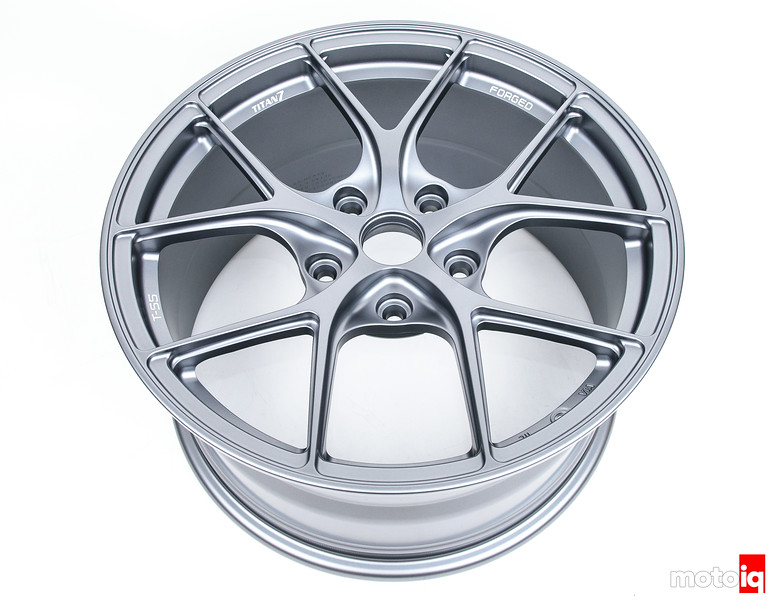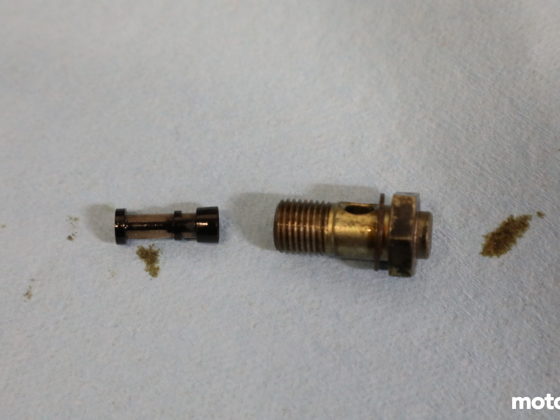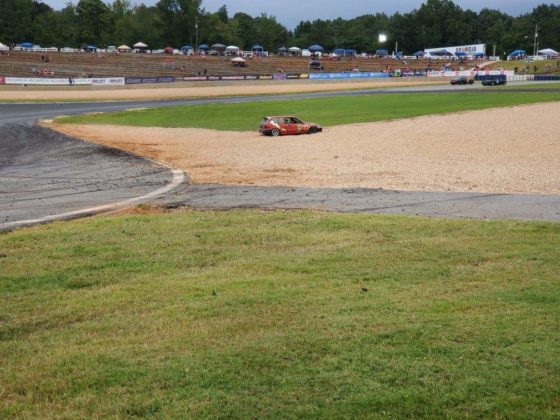
For wheels, we selected the Titan 7 T-S5 wheel. Titan 7 has developed a special fitment just for the 987 Porsche. Titan 7 forges their wheels with an industry-leading 10,000 tons of pressure using multi-stage dies. This forging process gives the wheels great grain orientation with excellent strength and mechanical properties. On the T-S5, the split 5 spoke design was selected for efficient strength to weight. In the spokes, you can see forged in ridges on the edges that help stiffness while keeping the overall weight of the spoke down.

In the wheels mounting pad, you can see that all excess material has been removed and the pad area hollowed out. This is done in the forging process, not by post forging machining to assure good grain flow and strength in this area. Little tricks like these assure that that wheels will be light. 17.5 lbs for the front wheel and 19.4 lbs for the rears. This is very light for 18″ wheels in a wide width! The wheels are designed to clear all popular big brake kits available for the 987.

The T-S5 has a knurled bead seat area to help prevent the tire from spinning on the rim. The inner rim flanges are also beefy for strength in this critical area. Our front wheel is 18×9 with a 48mm offset while the rear wheel is an 18×10 with 35mm offset allowing for an aggressive tire fitment with plenty of tire to fender clearance.

For tires, we needed something durable enough to be driven to the track even with aggressive alignment settings that still would over decent track grip. For this kind of use, the Nitto NT01 is one of the best choices. Its attributes that we have learned to love over the years are a long life on both the street and track grip with consistent performance through many heat cycles.
The tread is 6.2/32’s deep and can be shaved to 3/32’s for cooler running. At this point, the tire turns into a slick with two shallow circumferential grooves. However, we have never had an issue with heat build-up and chunking or we have not felt noticeable tread squirm with the NT01. Because of this, we feel that shaving is not needed or even recommended for the NT01 as it will reduce the service life which we feel is one of the tires best features! The tread compound is one of the things that contributes to the NT01’s on track staying power. Sure there are faster tires out there for sure but none can beat the NT01’s ability to give consistent grip all the way until the tread wears completely off and few can last as long. We have stretched the NT01 to easily last 3 complete racing weekends which is two races with qualifying and practice sessions over the weekend.




12 comments
Great as usual, curious to see how this does on the track. I run the atx-20 on my wrx. At three pounds and change it’s great. My car starts better with this over the factory battery, however it sits on a battery tender. While I haven’t had to use the restart feature, it’s another reason to like this battery.
Have you thought about this?
https://www.autoquestcars.com/custom-09
I would be careful and run a battery tender that is for lithum batteries only! A well-known friend of ours blew up his car and almost burned down his shop because he used the wrong trickle charger!
My opinion of this kit is that the upper links are way too short and you will have too much camber gain for rear-driven wheels. The short links can also contribute to jacking and lots of roll center and instant center migration. The short links will also cause side scrub which can contribute to instability on split mu surfaces and under certain load conditions. Lastly, the anti-squat percentage is really high and that can contribute to a loss of traction under corner exit as well as wheel hop. The Cayman/Boxter chassis has wheel hop as a known issue and they exhibit a high degree of anti.
I may be working with a well-known Porsche suspension parts company next year to develop my own solution to these issues on the 987 chassis which if it comes to fruition will be much better than this! At least in my own opinion.
Oh yeah, I use a lipo specific one. Not making that mistake. Lipo fires are for Richard Hammond anyways.
Competition is a wonderful thing, love to see what is born!
Got to run the car pretty hard today after some shock tuning. The owner reports that it’s pretty awesome.
Great articles. Looking forward for the next updates!
I enjoyed the 3 pages on the alignment and all of the other 987.2 Cayman content. Can you write more about setting the anti squat / dive front and rear? Also, about how the team measured the bump steer? All of the specs? Have you run the car on track yet? How did it feel, any adjustments?
I have a 987.2 will all of the Tarett parts that your car has and have not been able to find a shop around Atlanta that will got to this level of detail.
Thank you
We are waiting for softer front springs right now. I want to go down to 10 kg and KW is backordered. The balance of the car is ok but there is a minor pitch issue I think is frequency related so I want to go softer spring wise in the front and up in the front bar. As far as bump steer, Porsche is pretty well designed and there isn’t much, but if you mess with the roll center you need to move the tie rods by close to the same about or you will get bumpsteer. Basically, if you want to measure it you take off the springs and move the car up and down and measure toe every inch and plot it. However, we did this and the toe curve on these cars is pretty good. I would talk to my local PCA or POC racers and they probably know a prep shop that can properly align and corner balance your car. The specs we gave in the article were pretty aggressive like what cup cars run so they would kill your tire on the street if your car is a daily. To make it simple to reduce anti we shimmed the front trailing arm pivot down, The 987 has a lot in the rear.
Great looking build! I have a 987.2 I am setting up similarly for HPDE days.
Any chance you can provide some insight into your recommended ride height and how you came up with it?
I’ve got Ohlins on mine, and I have lowered it too far. My LCAs are pointed upward on the outside and thus my roll center is super low and my camber curve isn’t great. I’m trying to figure out how high to raise it but I’m a little lost.
Thanks!
We lowered the outer LCA pivot by putting a spacer on the spherical bearing. We also lowered the tie rod to reduce bump steer.
Okay cool. I have that ability with my front LCAs but I am still stock in the rear. Did you aim to have your LCAs at a certain angle at ride height or at full compression?
Mike, you’ve been on the Dundon podcast lately talking about suspension geometry and settings.
You guys keep talking about some controversial magical alignment settings that you’re using, but everybody acts like they’re common knowledge instead of saying what they are. Is it just adjusting the anti out?
No, you can’t just the anti out of a Cayman.